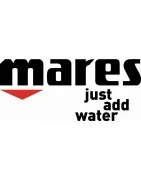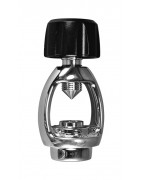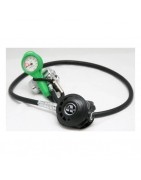
SCUBA Diving Regulators


POSEIDON Xstream Deep MK3 (1+2 stage) + Octopus Xstream

Atomic Aquatics B2 (1st and 2nd stage)

APEKS ATX 40 / DS4 + Octopus ATX40 + Manometer
- -16%

SCUBAPRO 2nd stage S600
- -10%

SCUBAPRO MK2 EVO - First stage
- -10%

SCUBAPRO MK17/S600
- -10%

APEKS 2 st. XTX 40
- -16%

APEKS XTX200 1st. Stage
- -16%

AQUALUNG Legend 3 + Legend Octo / LEG3ND

Octopus TECLINE TEC1 (2nd stage yellow)

AQUALUNG DIN-to-Yoke Converter

ATOMIC AQUATICS M1 (1st and 2nd stage)

SCUBAPRO MK17 EVO First stage
- -10%

SCUBAPRO MK25 EVO / S600 Regulator
- -10%

POSEIDON Jetstream MK3 + Octopus Jetstream Regulator

APEKS 2 st. XTX 50
- -16%

APEKS 1 st. DST
- -16%

1st stage TECLINE R2 Tec

2nd stage TECLINE TEC1 O2 Green

SCUBAPRO 2nd stage A700
- -10%

SCUBAPRO MK25 EVO/A700
- -10%

Scubapro MK25
- -10%

APEKS XTX 40 Octopus
- -16%
Scuba regulator - own or borrowed?
Divers, especially at the beginning of their diving adventure often ask themselves this question.
Scuba regulator is one of the more expensive items of diving equipment, requires maintenance, care about it, moreover, due to its complexity many divers are afraid that they will not be able to choose the right device for themselves, because it seems too difficult to study the laws of physics governing the operation of the device.
This is why many divers decide to purchase other pieces of equipment: jacket (wing), dry suit or wetsuit, leaving the subject of purchasing a regulator for the very end, while it is the most important piece of diving equipment together with a dive computer.
The regulator takes care of what we need most underwater - smooth and comfortable supply of the breathing medium, so it is definitely the piece of equipment which should be on our shopping list right after purchasing the dive computer, and preferably together with it.
Renting a regulator, although at first glance it seems to be an economical and not troublesome solution, in reality, it may cause many problems and a lot of discomfort.
The scuba regulators that can be rented in diving centres are the simplest, cheapest regulators and breathing comfort is not very high.
Most rental devices are very worn out, often they have damaged, bitten mouthpieces, and the disinfection process is also variable.
If you additionally use a dry suit during the dive or have a computer with a transmitter, you will face additional problems connected with the configuration of hoses connected to the first stage.
Your own scuba diving regulator means safety and comfort, and these are the most important elements in diving. There are also issues of hygiene, configuration, weight, breathing resistance and, what is particularly important, choosing the right regulator for your needs.
The construction of the regulator is important for individual preferences (see below), and the economic aspect is also a relative thing - modern regulators are of excellent quality and even those from the lower price range guarantee comfort and convenience which previous generations of divers could not dream of 20 or 30 years ago.
Construction and tasks of the scuba diving regulator
The regulator is the brain of our diving set - it manages the pressure reduction from the cylinder, distributes the air or diving gases to other elements of the equipment, such as the jacket (wing) and dry suit.
The scuba regulator consists of several components:
- first stage: screwed directly to the diving cylinder, it is in it that the first reduction of high gas pressure from the diving cylinder to about 10-15 at is made; we divide the types of the first stage on the basis of the mechanism and mode of operation into relieved and unrelieved, as well as piston and diaphragm type (dominating on the market nowadays), on the basis of the type of the valve connecting with the cylinder into DIN and INT, and also into automatons working with the pressure of 200 bar and 300 bar; the first stage has a certain number of ports HP (high pressure - usually one port) and LP (low pressure - usually 4 ports), thanks to which it is possible to connect other elements: The first stage has a certain number of HP ports (high pressure - usually one port) and LP ports (low pressure - usually 4 ports) which make it possible to connect other elements: second stage, spare second stage of the regulator (also called octopus), manometer, hose to the inflator or transmitter;
- second stage: from which we breathe directly, equipped with a mouthpiece which reduces the gas pressure to ambient pressure, it can also be unloaded or unbalanced, with the possibility of regulating the breathing resistance. Unbalanced second stages do not occur in practice any more, but you may come across many such used autmat systems, so it is worth paying attention.
We can say that the set of our regulator includes also a manometer (thanks to which we know the pressure in the cylinder) and hoses to the jacket and possibly dry-suit.
Of course we are talking here about classic one-bottle configuration, it will look a little different in case of two-bottle configuration like twinset or sidemount - Apeks and Tecline companies have ready-made sets for this type of configuration.
The best scuba diving regulators for recreational diving
Modern regulators are mostly diaphragm and balanced breathing apparatuses, technologically advanced devices, practically trouble-free and with high breathing comfort.
If we dive mainly in the vicinity of the diver's license at the Advanced level (i.e. at 20-30m depth) we can successfully purchase one of the basic models that will allow us to dive safely and comfortably and will not ruin our home budget, such as the Apeks ATX 40/DS4 set with ATX 40 Octopus and pressure gauge or Aqualung Core Supreme with Core Octopus and pressure gauge. These sets are immediately equipped with an acetopus and pressure gauge. If you do not have your own inflator hose, it is best to buy it in the set at once. Another big advantage of buying a regulator in a set is the fact that it comes immediately assembled and tested - ready to dive. As Mares slogan says "Just add water".
When diving deeper and in cold water it is worth considering a more advanced rebreather with solutions eliminating the possibility of the rebreather freezing underwater and with lower breathing resistance - then it is better to choose a more solid construction like the cult Aqualung Legend + Octopus Legend or Apeks XTX 200 with XTX 50 octopus.
The best scuba regulators for technical diving
The above mentioned regulators are also the choice of technical divers and at the same time the technical configurations for twinset or sidemount diving differ significantly from single cylinder configurations. Additionally, you need to take into account the more difficult conditions for such dives. They are longer and at greater depths. Therefore automatics for such dives must be fully reliable and have minimum breathing resistance.
Apeks offers ready sets for this type of diving activity - also ensuring oxygen purity.
Unique scuba diving regulators for airplane flights
For divers who particularly care about super light weight and every gram of equipment is important during long journeys, several manufacturers have created lightweight, travel scuba diving sets, which are not as popular due to their very delicate construction and low versatility in use (basically only in warm, tropical waters) e.g. Apeks Flight or Aqualung Micron.
Operation and maintenance of the scuba regulator
Modern regulators do not require any special additional training procedures - the knowledge gained during the basic diving course is enough to use and care for the equipment properly.
If we want our regulator to serve us for many years we should really remember about several important issues:
1. remember to rinse the regulator with fresh water after each dive, necessarily not allowing for flooding of the first stage socket (at the same time it is worth mentioning the excellent ACD system developed by Aqualung which causes the first stage to open only under pressure, so this problem will not occur here)
2. Let's regularly service our regulator in authorized service point of diving equipment (usually each diving store and diving center has its own service and trained staff)
3. always take with you a basic repair kit - spare hose, mouthpiece, or o-rings - it may come in handy during diving trips
Do not attempt to alter, modify, or repair the regulators on your own unless you have the appropriate training.
Desire to be underwater, or the history of the regulator origin
Finally, it is worth realizing that in fact the history of the regulator is the history of all diving - from ancient times to modern, advanced designs of regulators.
Since ancient times people have tried to go underwater - mainly for purely practical purposes - ship repair, extracting valuable artifacts from the wreck, but also fishing for pearls or catching shellfish.
The first ancient constructions in which man tried to provide a breathing medium were long tubes that allowed "snorkelling" at a maximum depth of about 2-2.5 meters, as well as leather bags with air. Some say that the first diving bells were already created in the days of Alexander the Great.
Leonardo da Vinci was the first to describe and present the design of the diving bell, but there is no evidence that based on his design such a device was built in those days.
Alfonso Borelli in the seventeenth century created the first idea of a diving system based on a helmet of boiled leather, tubes and air bags and even chemical absorbers of carbon dioxide, but the knowledge of physics at that time did not take into account the increase in pressure so this project was doomed to failure.
At the same time the first serious system was developed that made it possible in practice to stay underwater for up to 20 minutes - the so-called Helley's bell, which allowed even short-distance trips outside the diving bell.
In the eighteenth century another revolution took place - John Lethbridge constructed the first viable, individual diving system consisting of an oak cylinder with holes for arms and legs, powered from the surface, this device functioned successfully for many years.
It was not until the nineteenth century that Siebe's invention came - a functioning diving suit powered from the surface, although earlier attempts to create this type of device by the French doctor Ferminet (Machine Hydrostatergatique) or Klingert's system were also milestones in the development of diving.
Siebe and the Dean brothers (by some considered the creators of the diving helmet) competed in the market at the time and managed to sign many lucrative government contracts for their inventions, which allowed the penetration of the underwater world, but in those days were used mainly for military purposes.
People have always wanted to become independent from the breathing medium fed from the surface of the water - the first regulator - automatic breathing machine was born in 1865 and its creators were Benoit Rouquayrol and Auguste Denayrouse, their device Aerophere was a kind of cylinder with a pressure of 30 bar but it was still powered from the surface.
Yves Le Prieur made the diver independent from the power supply from the surface only in 1925, the diving cylinder was already loaded with air at a pressure of 150 bar and the diver could finally swim and move freely underwater.
Undoubtedly, the greatest invention, however, was the creation of a scuba diving regulator by Jacques Cousteau and Maurice Gagnan in 1942, and with it began the modern era of scuba diving. Interestingly, the regulator was based on a gas regulator taken out of a car.
It can be said that despite the fact that 80 years have passed since Cousteau and Gagnan created the scuba diving regulator, modern scuba regulators are only some variation of the original in terms of general design and principle of operation.
Taking a breath from your regulator, it is worth remembering these several centuries of history, the fate of the inventions of their creators, which led to the fact that the desire to be under water could become a reality.





Średnia ocena: 4.69
Na podstawie: 82 ocen











